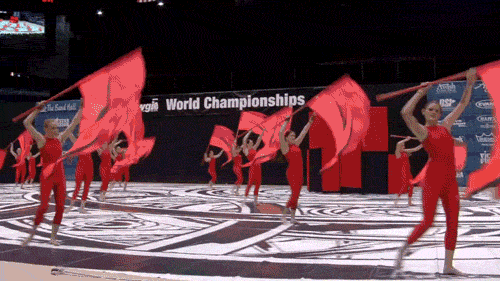“My knee is bothering me again. It keeps happening when we do X part of the show.”
Does this phrase sound familiar? If you’ve been around colorguards long enough you probably just had the face of a specific student or friend pop up in your mind.
Injuries run rampant in colorguard, but we have brushed it under the rug for years. It is not the instructor’s responsibility to know what to do about a student’s pain. Put some ice on it and rest it, maybe? That can work in isolated incidences, but in my 10+ years in the marching activity these injuries are no longer rare occurrences.
Colorguard members get hurt at an alarming rate, and it’s predominantly the female members who are suffering. There is a reason why.
What’s Happening?
In my time as the emergency medical responder and physical therapist for the Wando High School Marching Band, colorguard injuries fell into one of two categories: traumatic accidents or overuse injuries.
 The first of those two is nearly unavoidable in rehearsal; when you’re teaching a young person to spin a flag or toss a rifle for the first time they are going to jam a finger or get hit on the head at some point. That’s a part of their learning process, unfortunately.
The first of those two is nearly unavoidable in rehearsal; when you’re teaching a young person to spin a flag or toss a rifle for the first time they are going to jam a finger or get hit on the head at some point. That’s a part of their learning process, unfortunately.
What IS avoidable are all the chronic, overuse injuries that I see arising as the members mature physically and continue year-round with colorguard activities. I’m talking about the shoulder issues, the constant back aches, the unrelenting hip and knee problems that limit students during rehearsals. Many of these injuries are preventable!
Why Do Girls Hurt Worse?
To explain that, let’s focus on the area of the body that I see injured MOST often in colorguard – the knees. One prevalent type of knee pain, patellofemoral pain, is well over 2x as common in females as males! Some reasons for this have been disputed but remain unproven, such as females having wider hip than males causing increased forces at the knee. There are two explanations, however, that are definite.
Knee pain can likely be traced either to hip weakness or flat feet.
If you have knee pain, you may have noticed that your feet are “flat”. This is called pronation, and it has been shown to be more common in those with knee issues (1). Unfortunately, few colorguard shoes are supportive enough to help prevent this issue. If this describes you, it may be wise to invest in a shoe orthotic to give your foot stability while performing.
 Hip weakness has been shown to be more common in females than males, and may be the most likely explanation for why girls have knee problems more commonly than boys (2). Specifically, the hip extensors, abductors, and external rotators are weak in those with knee pain. These are essentially your butt and thigh muscles, and strengthening them is crucial to recovering from and preventing injury.
Hip weakness has been shown to be more common in females than males, and may be the most likely explanation for why girls have knee problems more commonly than boys (2). Specifically, the hip extensors, abductors, and external rotators are weak in those with knee pain. These are essentially your butt and thigh muscles, and strengthening them is crucial to recovering from and preventing injury.
How do we prevent it?
As stated earlier, if you think your feet and ankles may be the issue you should probably look into getting a custom orthotic. Talk to a podiatrist or physical therapist to see if you can get fitted for one, but remember you want something that can work in your colorguard shoes.
Also, exercise! By exercise, I don’t mean stretching. Most colorguard members have actually over-stretched their joints and sacrificed stability for having more motion. There has to be a balance between stretching and strengthening. Strengthening your core and leg muscles has been proven to prevent these injuries (3).
To improve hip strength specifically for colorguard, do exercises that target the glutes, hip abductors, and external rotators. Bridges and squats are a great starting point. For more targeted exercises, check out what we have used at Wando: (link: https://www.youtube.com/watch?v=PopziqknVy8).
Thanks for reading! If you found this article helpful, please share it on social media. I also love hearing from my audience. Contact me with any questions or comments that you may have!
References:
1. Petersen W, Ellermann A, Gösele-Koppenburg A, et al. Patellofemoral pain syndrome. Knee Surgery, Sports Traumatology, Arthroscopy. 2014;22(10):2264-2274. doi:10.1007/s00167-013-2759-6.
2. Boling M, Padua D, Marshall S, Guskiewicz K, Pyne S, Beutler A. Gender differences in the incidence and prevalence of patellofemoral pain syndrome. Scandinavian journal of medicine & science in sports. 2010;20(5):725-730. doi:10.1111/j.1600-0838.2009.00996.x.
3. Leetun DT, Ireland ML, Willson JD, Ballantyne BT, Davis IM. Core Stability Measures as Risk Factors for Lower Extremity Injury in Athletes. Medicine & Science in Sports & Exercise. 2004;36(6):926-934. doi:10.1249/01.mss.0000128145.75199.c3.

